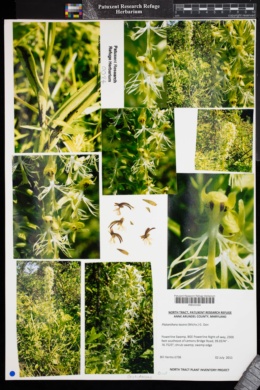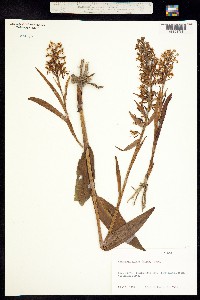Platanthera lacera
|
|
|
|
Family: Orchidaceae
Green Fringed Orchid
[Blephariglottis lacera (Michx.) Farw., moreHabenaria lacera (Michx.) R. Br.] |
Plants 14-80 cm. Leaves 1-4, wide-spreading to ascending, scattered along stem, gradually to abruptly reduced to bracts distally; blade linear-lanceolate, linear-oblong, or oblong-obovate, 7-23 × 0.7-5 cm. Spikes lax to dense. Flowers resupinate, not showy to inconspicuous, whitish green or yellowish green, lip often paler; lateral sepals reflexed; petals linear to narrowly oblong-spatulate, margins entire or apex rarely slightly lacerate; lip descending, without basal thickening, deeply 3-lobed, 10-17 × 13-17 mm, lobes extensively and deeply divided, commonly into filiform divisions, margins rarely merely fringed or middle lobe merely lacerate-fringed, lateral lobes narrowly to broadly cuneate, middle lobe cuneate-flabellate, usually narrow; spur slenderly to markedly clavate, 11-23 mm; rostellum lobes nearly parallel, directed downward, short, rounded; pollinaria nearly straight; pollinia remaining enclosed in anther sacs; viscidia linear; ovary slender to stout, mostly 8-20 mm. 2n = 42. Flowering May--Aug. Sphagnum bogs, alluvial and swamp forests, stream banks, riparian meadows, sand flats, moist and seeping slopes, prairies, roadside banks, ditches, old fields, borrow pits; 0--1200 m; Man., N.B., Nfld. and Labr. (Nfld.), N.S., Ont., P.E.I., Que.; Ala., Ark., Conn., Del., D.C., Ill., Ind., Kans., Ky., Maine, Md., Mass., Mich., Minn., Miss., Mo., N.H., N.J., N.Y., N.C., Ohio, Okla., Pa., R.I., S.C., Tex., Vt., Va., W.Va., Wis. Hybrids with Platanthera grandiflora (P. ×keenanii P. M. Brown; see note under 20. P. grandiflora) and P. psycodes [P. × andrewsii (M. White) Luer] are variably intermediate between the parents, with various purple-green shadings and lobes of the lip generally narrower and more dissected than in the purple-flowered parents. The linear viscidia of P. lacera and the large anther sacs of P. grandiflora provide means for determination. The ratio of viscidium length/width of 1-3.2 distinguishes hybrids and purple-flowered parents from P. lacera, which is characterized by a ratio of 2.7-4.6. The parentage of hybrids can be determined by different sized anther sacs: P. ×andrewsii, 1.4-2.3 mm; P. ×keenanii, 2.5-4.2 mm. Those hybrids can be distinguished from their purple-flowered parents by less intense coloring and the ratio of viscidium length/width: P. psycodes 1-1.5; P. × andrewsii, 1.3-3; P. grandiflora, 1-1.5; P. × keenanii, 1.5-3.2. The plants known as Platanthera lacera var. terrae-novae (Fernald) Luer (Habenaria lacera var. terrae-novae Fernald) apparently represent swarms of P. × andrewsii and introgressed P. lacera (P. M. Catling and V. R. Catling 1994).
Perennial herb 14 - 80 cm tall Stem: single, erect, green, slender to stout, slightly angular, almost winged on angles, hairless, leafy with reduced bracts toward inflorescence. Leaves: one to four, alternate and scattered, stalkless, erect and sheathing at first, later spreading and barely sheathing, hairless, non-toothed, gradually or abruptly reduced to bracts upwards, 7 - 23 cm long, 0.7 - 5 cm wide, linear to lance-shaped or more oblong. Inflorescence: a single, erect, terminal, hairless, 5 - 25 cm tall, loose to dense, spike-like cluster of twenty to thirty almost stalkless flowers with each flower subtended by a small bract. The 1.2 - 1.5 cm long, 2 - 4 mm wide, lance-shaped, non-toothed, hairless bracts are never longer than the flowers. Flowers: not showy, green to whitish green or yellowish, hairless, under 3 cm diameter, bilaterally symmetric with center sepal and upper petals above the prominent, highly modified, three-lobed, deeply-fringed lip petal, which has base modified into a slender nectar spur. The reproductive parts of stamens, stigma and style are fused into a column above the 0.8 - 2 cm long inferior ovary. Sepals: three, green, hairless, non-toothed, up to 6 mm long, mostly egg-shaped with blunt tips. The lateral sepals are reflexed and a little longer and narrower (3 - 6 mm long, 2 - 3 mm wide) than the central, uppermost, more forward-facing sepal, which is typically only 3 - 5 mm long but 2 - 4 mm wide. Central sepal closely positioned with lateral petals, together arching over lip petal and column. Fruit: several to numerous, erect, very short-stalked, narrowly ellipsoid capsules with three lengthwise ridges, and subtended by fairly spreading bracts. Roots: fleshy and thickened. Lateral petals: two, fairly close together, curving forward over column, green, hairless, 3 - 7 mm long, 0.5 - 2 mm wide, linear to narrowly oblong, blunt at tip, very rarely with inconspicuous small teeth. Lip petal: one, central, lowermost, descending, light green to greenish white, hairless, 0.8 - 1.7 cm long and wide, egg-shaped in outline, but deeply three-lobed (lobes often hard to differentiate) with each narrow lobe deeply cut and divided almost to base into very slender threadlike segments. The base of the lip petal is modified into a curved, 0.8 - 2.3 cm long, fairly slender club-shaped spur. Similar species: Platanthera lacera is probably most often confused with P. leucophaea, but those flowers tend to be more white, the lateral petals are obviously much wider (wedge-shaped) with the broad tip always finely toothed, the lobes of the lip are more evident and not as deeply divided into narrow fringes (fringe rarely extends even half the length of the lobes), and the spur is typically longer (over 2 cm). Flowering: June to August Habitat and ecology: Uncommon, typically in sterile acid soils that do not become completely dry; preferring sunny, more moist, mildly acidic soils such as the sunny parts of acid bogs, peaty sand prairies, and occasionally in mesic prairies. Occurence in the Chicago region: native Notes: This green orchid is often overlooked due to its overall green color, but also plants tend to be visible one year and then absent the next year at the same site. This more northern orchid has been observed to be spreading southward, at least in Illinois and Indiana (Homoya 1993). Hybrids of P. lacera and P. psycodes are called P. x andrewsii, but the breeding seasons for the parent species rarely overlap in the Chicago Region and thus the hybrid is more commonly seen farther north of our area and also in New England. The hybrid is highly variable in terms of the lip shape, fringe, and color combinations (Case 1987). Etymology: Platanthera comes from the Greek words platys, meaning flat or broad, and anthera, meaning anther, which refers to the wide anther of the genus. Lacera means torn, which refers to the deeply fringed lip petal. Author: The Field Museum Stem 3-8 dm; lower lvs lanceolate to oval, to 15 × 4 cm, acute or blunt; upper lvs much reduced, nearly linear; infl usually compact and many-fld, 5-15(-20) × 3-5 cm; fls pale yellow-green to greenish-white; sep broadly oval, 4.5-7 mm, the lateral ones deflexed behind the lip; lateral pet linear-spatulate, about equaling the sep, blunt, entire; lip 11-16 mm, deeply 3-lobed, each lobe cuneate, fringed with a few long segments at the end only, the terminal lobe long-clawed, the lateral ones cut to below the middle or nearly to the base; spur 14-21 mm, about equaling the ovary; 2n=42. Open, wet, sunny places; Nf. to se. Man., s. to S.C., Ga., Ala., Ark., and ne. Okla. June- Aug. (Blephariglottis l.; Platanthera l.) A hybrid with no. 19 [Habenaria psycodes (L.) Spreng] is H. ءndrewsii M. White. Gleason, Henry A. & Cronquist, Arthur J. 1991. Manual of vascular plants of northeastern United States and adjacent Canada. lxxv + 910 pp. ©The New York Botanical Garden. All rights reserved. Used by permission. From Flora of Indiana (1940) by Charles C. Deam This species is somewhat frequent in the lake area and has a wide range of habitats. It is usually found in tamarack bogs, marshes, and marshy and springy places anywhere. I once found it under a beech tree in a woods and once in a sandy, fallow field that had been fallow for at least 25 years. In addition to the counties indicated on the map it has been reported from Fulton, Lake, and Marshall Counties. …… Indiana Coefficient of Conservatism: C = 4 Wetland Indicator Status: FACW |
|
|
|






































































